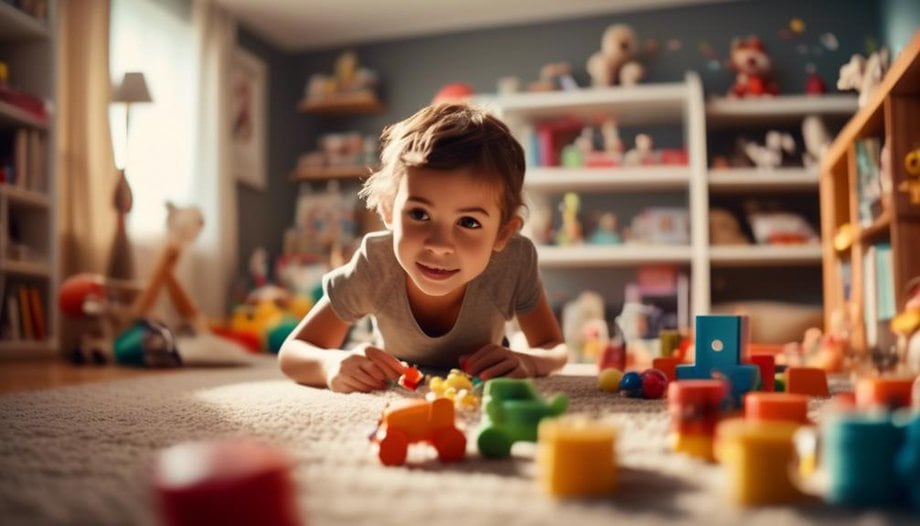How Setting Clear Boundaries Improves Child Behavior

Setting clear boundaries improves child behavior. It does this by fostering emotional regulation, enhancing communication skills, promoting independence, and creating a safe environment.
The Role of Clear Boundaries in Parenting
Clear boundaries play a crucial role in effective parenting, providing children with the structure and guidance they need to develop positive behavior. Establishing healthy boundaries is essential for promoting positive behavior in children. When children have clear boundaries, they understand what's expected of them and what behaviors are acceptable. This clarity helps them feel secure and confident in their actions, knowing that they're following the rules set by their parents.
Boundaries help children develop self-discipline and self-control. By clearly defining limits and consequences, parents teach their children about responsibility and accountability. When children know the consequences of their actions, they're more likely to think before they act and consider the potential outcomes. This helps them make better choices and develop positive behavior patterns that will benefit them throughout their lives.
In addition, clear boundaries provide children with a sense of stability and predictability. They know what to expect and feel more secure when they have a consistent framework to follow. This stability helps reduce anxiety and stress, allowing children to focus on learning and growing.
Establishing Clear Expectations for Behavior
Establishing expectations for behavior is a pivotal aspect of effective parenting, as it provides children with a framework for understanding and navigating the world around them. When you set clear and healthy boundaries, you're giving your child a roadmap for how to behave in different situations. By doing so, you're promoting positive behavior and helping your child develop essential life skills.
Children thrive on structure and routine. When you establish clear expectations for behavior, you're creating a stable environment where your child feels safe and secure. They know what's expected of them, which helps to reduce anxiety and uncertainty. This, in turn, allows them to focus on learning, growing, and developing their potential.
Setting expectations also teaches your child about responsibility and accountability. By clearly outlining what's acceptable and what's not, you're teaching them about the consequences of their actions. This empowers them to make thoughtful choices and understand the impact of their behavior on themselves and others.
When you establish healthy boundaries, you aren't only teaching your child about appropriate behavior, but you're also instilling important values and principles. By consistently enforcing these expectations, you're helping your child develop self-discipline, respect for others, and a strong moral compass.
Setting Limits and Consistency in Discipline
To effectively guide your child's behavior, it's crucial to set and consistently enforce clear limits and boundaries in discipline. Limit setting is essential for teaching children about acceptable behavior and helping them understand the consequences of their actions. By establishing clear boundaries, you provide your child with a framework for understanding what's expected of them and what's not. This clarity helps them feel secure and confident in their environment.
Consistency in discipline is equally important. Children thrive on routine and predictability. When you enforce the same consequences for the same behaviors consistently, your child learns that their actions have predictable outcomes. This consistency helps them understand cause and effect and makes it easier for them to internalize and follow the rules.
When setting limits and enforcing discipline, it's vital to be firm but fair. Avoid being overly strict or lenient, as both approaches can be detrimental to your child's development. Instead, find a balance that allows for flexibility when appropriate while maintaining the structure and consistency that children need.
Teaching Responsibility and Accountability
Teaching responsibility and accountability to your child is essential for their development and growth. By nurturing their sense of self-discipline, you're equipping them with the tools to make responsible decisions and take ownership of their actions.
Fostering independence allows them to learn from their mistakes and become accountable for their choices, ultimately shaping them into responsible individuals.
Developing Self-Discipline
Developing self-discipline is essential for fostering responsibility and accountability in children, allowing them to thrive in various aspects of their lives. By building resilience, children learn to bounce back from adversity and setbacks, developing the mental toughness needed to face challenges head-on.
Promoting self-control empowers children to resist temptations and make wise choices, leading to better decision-making skills and improved impulse control. Teaching delayed gratification helps children understand the importance of patience and perseverance, enabling them to work towards long-term goals and resist instant gratification.
Encouraging self-monitoring allows children to become aware of their actions and behaviors, taking responsibility for their own actions and learning from their mistakes. Instilling self-discipline in children empowers them to become accountable individuals who can navigate through life's obstacles with integrity and determination, ultimately leading to personal growth and success.
Fostering Independence
As children develop self-discipline, they also cultivate the necessary skills for fostering independence, such as teaching responsibility and accountability.
Promoting autonomy and encouraging decision-making are essential aspects of fostering independence in children. By giving them age-appropriate tasks and responsibilities, you're teaching them the importance of taking ownership of their actions and choices.
When children are allowed to make decisions and take responsibility for their outcomes, they develop a sense of accountability that will serve them well in the future. It's crucial to provide guidance and support while also giving them the space to learn from their mistakes.
Fostering Emotional Regulation Through Boundaries
To foster emotional regulation in children, establishing clear boundaries is essential. When children have clear boundaries, they understand what's expected of them and feel secure in their environment. This sense of security helps them develop emotional self-regulation skills, which are crucial for managing their behavior and emotions effectively.
Here are five ways that setting clear boundaries can foster emotional regulation in children:
- Promotes a sense of safety and predictability: Clear boundaries create a structured environment that children can rely on. This predictability helps them feel safe and secure, reducing anxiety and promoting emotional stability.
- Teaches self-control: Boundaries provide children with opportunities to practice self-control. By respecting and adhering to the boundaries set by their caregivers, children learn how to manage their impulses and emotions.
- Encourages emotional expression: When children know the limits and boundaries, they feel more comfortable expressing their emotions in a healthy and appropriate manner. They understand that their feelings are valid, and they're encouraged to communicate them effectively.
- Enhances problem-solving skills: Boundaries teach children to think critically and find solutions within the given limits. By setting boundaries, caregivers encourage children to develop problem-solving skills and learn to navigate challenging situations.
- Builds resilience: When children understand and respect boundaries, they develop resilience. They learn to adapt to different situations, cope with setbacks, and manage their emotions effectively.
Enhancing Communication and Conflict Resolution Skills
By strengthening their understanding of boundaries, children can further enhance their communication and conflict resolution skills, allowing them to navigate interpersonal relationships with confidence and effectiveness. Effective communication skills are essential for healthy relationships and can be cultivated through setting clear boundaries.
When children understand and respect boundaries, they learn to express their thoughts and emotions effectively, listen actively, and empathize with others. They develop the ability to articulate their needs and desires, while also being receptive to the needs of others.
Conflict resolution techniques play a vital role in maintaining harmonious relationships. Teaching children how to address conflicts in a constructive and respectful manner empowers them to find mutually beneficial solutions and prevent the escalation of disagreements. This involves teaching them active listening, effective problem-solving, compromise, and negotiation skills.
Promoting Independence and Self-Confidence
Promote your child's independence and self-confidence by encouraging them to take on new challenges and explore their own capabilities. When children have the opportunity to develop autonomy and build self-esteem, they become more resilient, confident, and capable individuals. Here are some ways you can support your child's growth in these areas:
- Encourage decision-making: Allow your child to make choices and decisions, even if they're small ones. This helps them develop their decision-making skills and feel a sense of control over their own lives.
- Provide opportunities for responsibility: Give your child age-appropriate responsibilities, such as taking care of their belongings or completing household chores. This fosters a sense of independence and teaches them important life skills.
- Support their interests: Encourage your child to pursue activities and hobbies they're passionate about. This not only allows them to explore their talents and interests but also boosts their self-confidence as they excel in their chosen pursuits.
- Celebrate achievements: Acknowledge and celebrate your child's accomplishments, no matter how big or small. This positive reinforcement helps build their self-esteem and motivates them to continue striving for success.
- Foster problem-solving skills: Encourage your child to think critically and find solutions to challenges they encounter. By allowing them to problem-solve independently, you're promoting their autonomy and building their confidence in their own abilities.
Creating a Safe and Secure Environment
As your child gains independence and self-confidence, it's essential to create a safe and secure environment that supports their growth and development. Promoting healthy development starts with providing a space where your child feels protected and nurtured. By establishing clear boundaries and guidelines, you can create a sense of structure that fosters positive behavior.
Building trust and respect is crucial in creating a safe and secure environment. When your child feels safe, they're more likely to explore and take risks, which are essential for their growth. Trust is built through consistent and reliable interactions, where you follow through on your promises and commitments. Respect is shown by listening to your child, valuing their opinions, and acknowledging their feelings.
A safe and secure environment also means ensuring physical safety. Keep your home childproofed, removing any hazards that could harm your child. Additionally, develop routines and schedules that provide a sense of predictability and stability. This helps your child feel secure and understand what's expected of them.
Frequently Asked Questions
What Are Some Effective Strategies for Setting Clear Boundaries With Children?
To effectively set clear boundaries with children, you can use strategies such as consistent communication, positive reinforcement, and leading by example. These approaches help establish expectations and promote positive behavior in children.
How Can Parents Ensure That Their Expectations for Behavior Are Clear and Easily Understood by Their Children?
To ensure your expectations for behavior are clear and easily understood by your children, focus on effective parenting techniques and communication skills. By setting clear boundaries and explaining them in a way they can relate to, you'll foster better behavior.
What Are Some Practical Ways to Establish Consistency in Discipline When Setting Limits?
To establish consistency in discipline and set limits, you can use practical techniques like creating clear rules, enforcing consequences, and maintaining open communication. Consistency benefits include improved behavior and a sense of security for your child.
How Can Parents Teach Their Children the Importance of Responsibility and Accountability Through Setting Clear Boundaries?
You can teach your children responsibility and foster accountability by setting clear boundaries. When they understand the importance of following rules and taking ownership of their actions, their behavior improves.
Are There Any Specific Techniques or Approaches That Can Be Used to Foster Emotional Regulation in Children Through the Use of Boundaries?
To foster emotional regulation in children, try using boundaries as a tool for self-control. Teach them techniques like deep breathing or counting to 10 when they feel overwhelmed. Boundaries provide structure and help children understand their emotions better.










